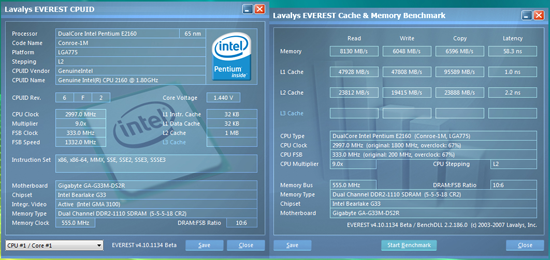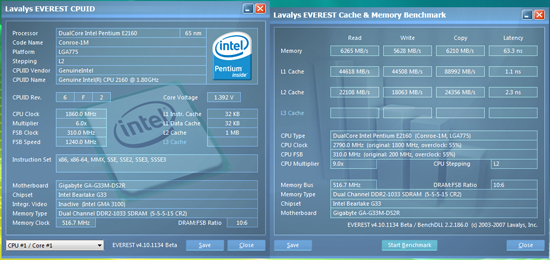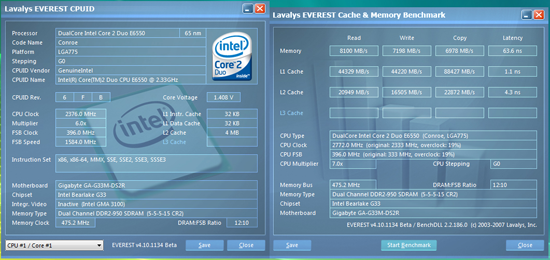µATX Part 2: Intel G33 Performance Review
by Gary Key on September 27, 2007 3:00 AM EST- Posted in
- Motherboards
Gigabyte GA-G33M-DS2R: Overclocking
Our best results with the integrated graphics solutions was a final benchmark stable setting of 9x333 FSB resulting in a clock speed of 2997MHz. This required a CPU voltage setting of 1.450V on this board. Unlike the ASUS board, we were able to crank the memory speed up DDR2-1110 with timings at 5-5-5-18 at a voltage of 2.2 which is the absolute limit of our memory (and really a little more than we thought it would do). What did this buy us in terms of application performance improvements outside of SuperPI, Sandra, or Everest? Nothing really, as the few application benchmarks that are memory throughput sensitive only improve by a percent or so.
Utilizing the E2160 and external GPU we reached a final benchmark stable setting of 9x310 FSB resulting in a clock speed of 2790MHz with a CPU voltage setting of 1.425V. Memory settings were once again aggressive on this board with a DDR2-1033 speed and timings at 5-5-5-15 at 2.10V. The board was actually capable of running at 9x375 FSB with our modified E2160. Vdrop/Vdroop was acceptable with a decrease of around .02~.04V during load testing.
The E6550 reached 7x396 at voltage settings of 1.425V which is far below the 7x485 capability of the ASUS and MSI boards. We tried other 1333MHz FSB CPUs with the same results, and any setting over 400FSB resulted in sporadic operation or no POST conditions. It appears to us that the BIOS is not properly setting the strap timings. Our memory speed was set at DDR2-950 with timings at 5-5-5-15 and 2.1V.
We were hoping for better results with our 1066MHz FSB based Q6600 but were met with a 9x350FSB limit at 1.3875V resulting in a CPU speed of 3150MHz. Once again, this board allowed us to run fairly highly memory speeds unlike the ASUS board, but at the expense of sub-timings. The final memory speed was DDR2-1050 at 5-5-5-18 timings.
 |
| Click to enlarge |
Our best results with the integrated graphics solutions was a final benchmark stable setting of 9x333 FSB resulting in a clock speed of 2997MHz. This required a CPU voltage setting of 1.450V on this board. Unlike the ASUS board, we were able to crank the memory speed up DDR2-1110 with timings at 5-5-5-18 at a voltage of 2.2 which is the absolute limit of our memory (and really a little more than we thought it would do). What did this buy us in terms of application performance improvements outside of SuperPI, Sandra, or Everest? Nothing really, as the few application benchmarks that are memory throughput sensitive only improve by a percent or so.
 |
| Click to enlarge |
Utilizing the E2160 and external GPU we reached a final benchmark stable setting of 9x310 FSB resulting in a clock speed of 2790MHz with a CPU voltage setting of 1.425V. Memory settings were once again aggressive on this board with a DDR2-1033 speed and timings at 5-5-5-15 at 2.10V. The board was actually capable of running at 9x375 FSB with our modified E2160. Vdrop/Vdroop was acceptable with a decrease of around .02~.04V during load testing.
 |
| Click to enlarge |
The E6550 reached 7x396 at voltage settings of 1.425V which is far below the 7x485 capability of the ASUS and MSI boards. We tried other 1333MHz FSB CPUs with the same results, and any setting over 400FSB resulted in sporadic operation or no POST conditions. It appears to us that the BIOS is not properly setting the strap timings. Our memory speed was set at DDR2-950 with timings at 5-5-5-15 and 2.1V.
 |
| Click to enlarge |
We were hoping for better results with our 1066MHz FSB based Q6600 but were met with a 9x350FSB limit at 1.3875V resulting in a CPU speed of 3150MHz. Once again, this board allowed us to run fairly highly memory speeds unlike the ASUS board, but at the expense of sub-timings. The final memory speed was DDR2-1050 at 5-5-5-18 timings.










26 Comments
View All Comments
sprockkets - Friday, September 28, 2007 - link
Sad how an AMD 7050 board can be had for $80, $40 cheaper with the same features. It is the premium you pay for having dvi.Oddly enough too is that the Gigabyte board you quote doesn't use all solid caps yet the lower end board does. And of course, they didn't bother with solid caps on their new AMD boards period, cause "AMD is second tier."
tayhimself - Thursday, September 27, 2007 - link
Preposterous!! Why do they even bother making this junk without DVI. More and more I find that I don't want a leet board that overclocks 100 Mhz higher but a stable board with the right features. -sigh-8steve8 - Thursday, September 27, 2007 - link
and on top of it, these igp's are not suited well for gaming or videos,,, (the two applications where you may not notice the difference between a digital and analog interface), so they will be used for text/office work... an application where the discrepancies in the user-experience of analog vs digital interfaces with an LCD are undeniable.again, great article.,, but in the end, I sort of wonder why waste ur time exploring these boards when your time is better spent on solutions that deserve our money?
JarredWalton - Thursday, September 27, 2007 - link
I think both of those G33 + SDVO models launched long after Gary had started work on this uATX stuff. Good to see that some people are including the necessary chip, as uATX without DVI is simply unacceptable. Unfortunately, testing some of this stuff takes a lot more time than we would like. We're working to address that, however.jenli - Thursday, September 27, 2007 - link
I would love to see a review of motherboards with igpthat can be converted to raid servers by using the lone
pcie 16x slot.
Have fun,
CK804 - Thursday, September 27, 2007 - link
I'm doing exactly what you mention with an Intel DG965RY. I have an Areca ARC-1210 fitted in there with 3 320GB WD Caviar SE16s in RAID 5.